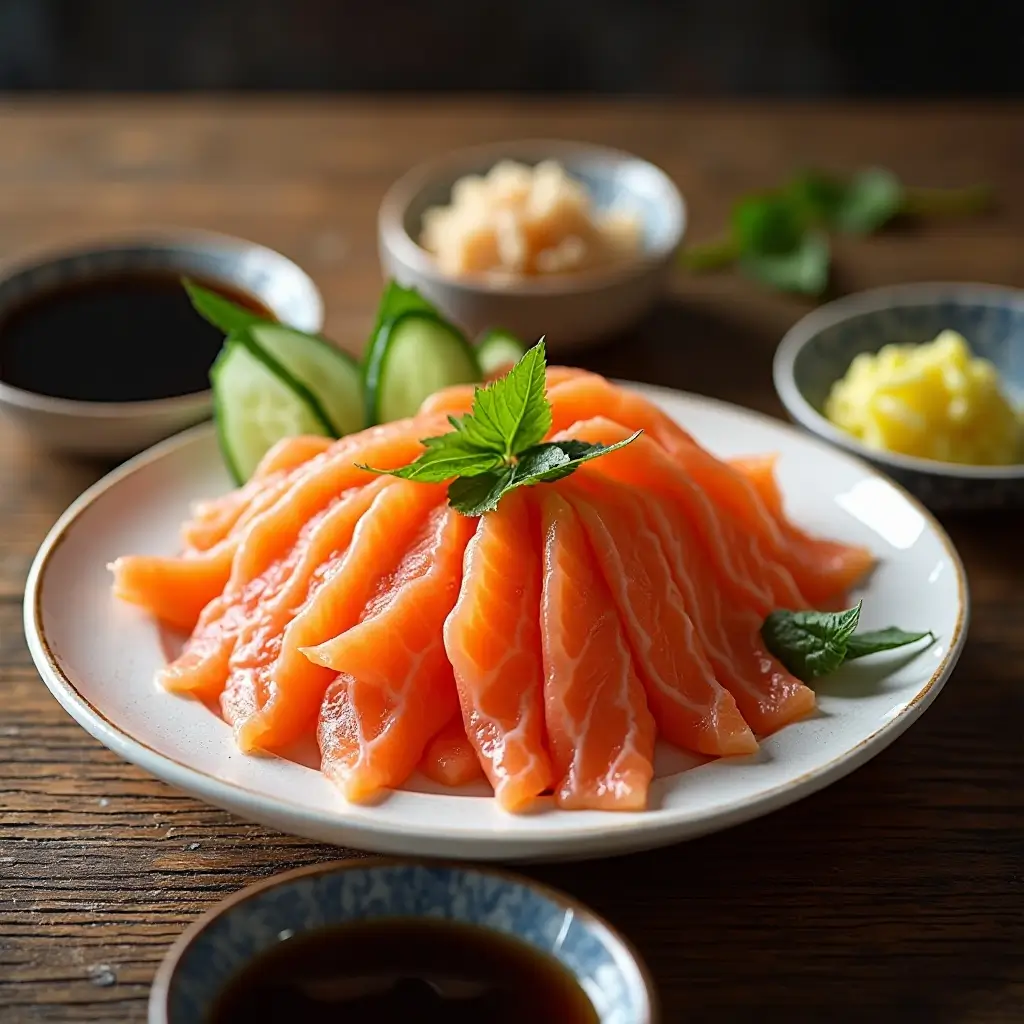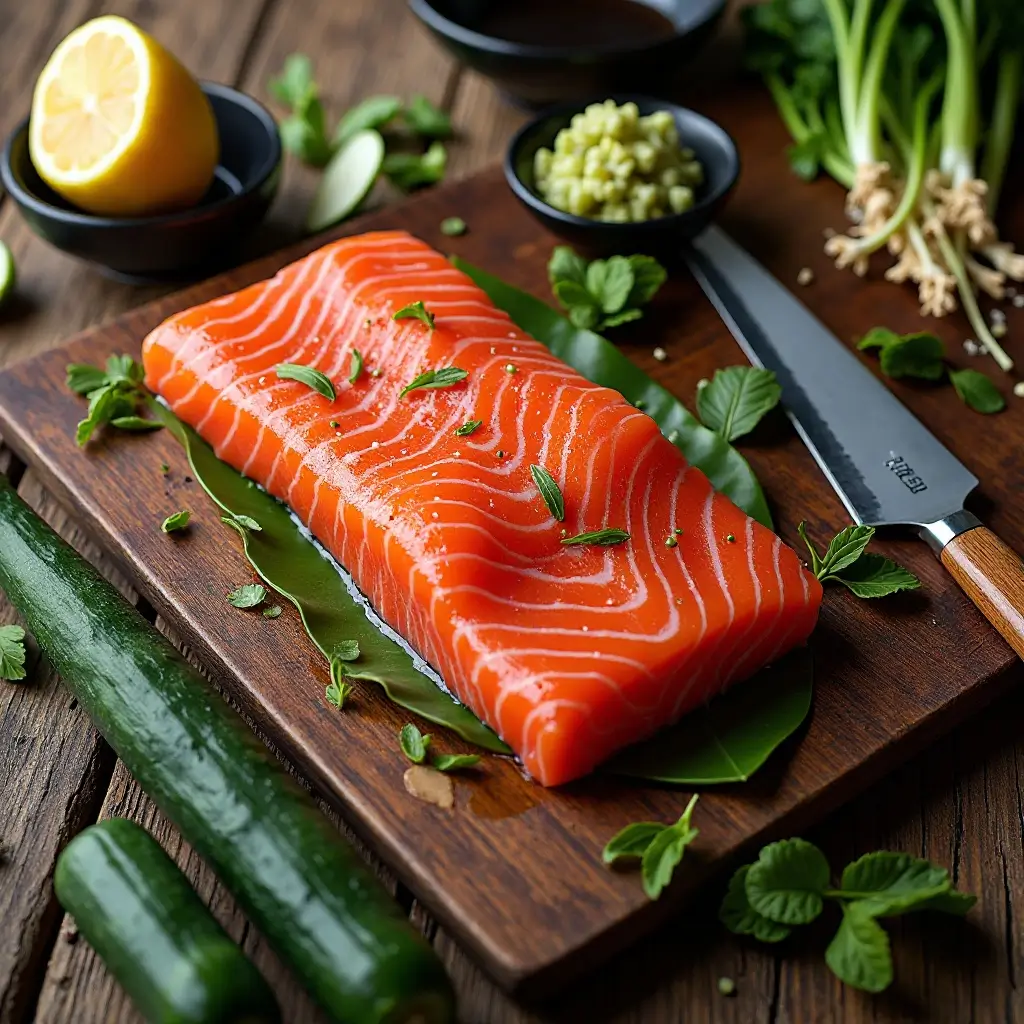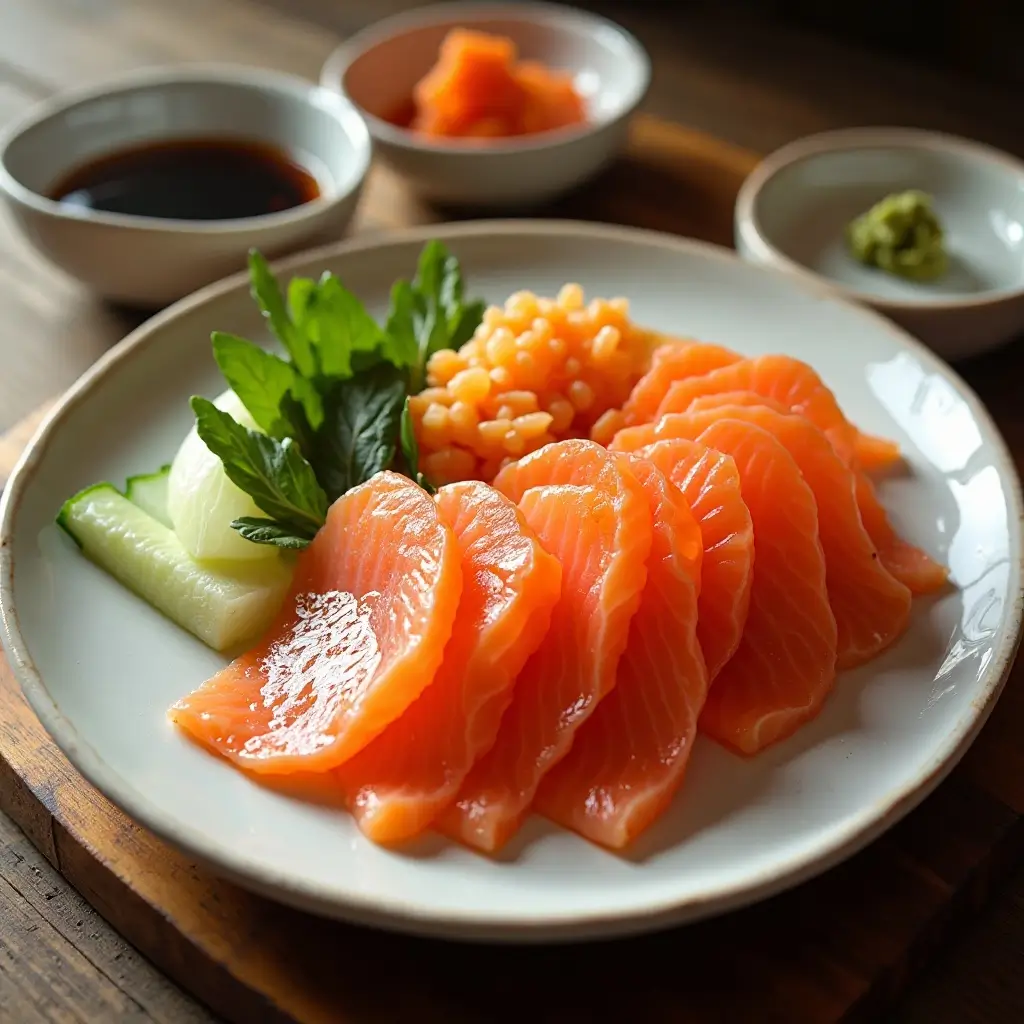15 Minute Salmon Sashimi Recipe
Picture this: silky, melt-in-your-mouth salmon sashimi that rivals your favorite Japanese restaurant, made right in your own kitchen. This elegant dish transforms premium salmon into buttery perfection with minimal effort and maximum flavor.
Here’s a fun fact – sashimi literally means “pierced body” in Japanese, referring to the ancient practice of attaching the fish’s tail to identify the catch. What makes salmon sashimi truly special is its pure simplicity and restaurant-quality results in just 15 minutes.
Unlike our popular teriyaki salmon bowls that require cooking, this raw delicacy celebrates the fish’s natural flavor and texture. Get ready to impress your family and friends with this surprisingly accessible gourmet experience!
Table of Contents
What is Salmon Sashimi?
Ever wondered why this Japanese delicacy sounds so mysterious? Salmon sashimi is simply the art of slicing premium raw salmon into perfect bite-sized pieces that showcase the fish’s natural beauty and flavor.
The name “sashimi” might sound fancy, but it’s really just Japanese for “sliced raw fish” – nothing too complicated there! Here’s the thing: creating restaurant-quality sashimi at home is like unlocking a secret culinary superpower.
After all, they say the way to a person’s heart is through their stomach, and nothing says “I care” quite like hand-cut sashimi. Ready to become the sashimi master of your kitchen?
Why You’ll Love This Salmon Sashimi
Fresh, Restaurant-Quality Results at Home The main highlight of homemade salmon sashimi is the incredible freshness and quality you can achieve. When you select your own sushi-grade salmon and slice it fresh, you’re getting restaurant-quality results without the premium price tag. The buttery texture and clean, oceanic flavor of properly prepared salmon sashimi is simply unmatched.
Significant Cost Savings Making salmon sashimi at home can save you up to 70% compared to ordering at restaurants. A single serving at a sushi restaurant can cost $15-25, while the same portion made at home costs around $5-8. Plus, you get the satisfaction of creating something beautiful and delicious with your own hands.

Simple Ingredients, Maximum Impact What makes this dish truly special is how few ingredients you need to create something extraordinary. Premium sushi-grade salmon, soy sauce, wasabi, and pickled ginger are all you need. The key is in the knife work and presentation. Unlike our popular salmon teriyaki recipe that requires multiple cooking steps, sashimi celebrates the pure, unadulterated flavor of the fish.
The clean, minimalist approach to this dish makes it perfect for special occasions or when you want to treat yourself to something luxurious. Ready to transform your kitchen into a high-end sushi counter?
How to Make Salmon Sashimi
Quick Overview
Salmon sashimi is surprisingly simple to master once you understand the basics. This elegant dish requires no cooking – just precise knife work and quality ingredients. The key is using sushi-grade salmon and a sharp knife to create uniform, restaurant-quality slices.
Preparation Details:
- Prep Time: 15 minutes
- Total Time: 15 minutes
- Skill Level: Intermediate
- Servings: 2-4 people
The beauty of sashimi lies in its simplicity and the pure, clean flavor of premium raw fish. With the right technique, you’ll create silky, melt-in-your-mouth pieces that rival any high-end sushi restaurant.
Key Ingredients for Salmon Sashimi
Main Ingredients:
- 8 oz sushi-grade salmon fillet (skin removed)
- 2 tablespoons soy sauce (preferably low-sodium)
- 1 teaspoon wasabi paste
- 2 tablespoons pickled ginger (gari)
- 1 tablespoon sesame oil (optional)
For Garnish:
- Fresh shiso leaves or lettuce
- Thinly sliced cucumber
- Radish sprouts
- Lemon wedges
Essential Equipment:
- Very sharp sashimi knife or chef’s knife
- Clean cutting board (preferably wood or bamboo)
- Small serving plates
- Tweezers for removing any small bones
Pro tip: Always buy your salmon from a reputable fishmonger and specifically ask for “sushi-grade” or “sashimi-grade” fish to ensure safety and quality.

Step-by-Step Instructions
Step 1: Prepare Your Workspace
Clean and sanitize your cutting board and knife thoroughly. Place the salmon fillet on the cutting board and inspect it for any remaining bones, removing them with clean tweezers if found.
Step 2: Chill the Salmon
Place the salmon in the freezer for 10-15 minutes before slicing. This firms up the flesh slightly, making it easier to achieve clean, precise cuts.
Step 3: Perfect Your Knife Technique
Hold your knife at a 45-degree angle to the salmon. Using long, smooth strokes, slice the salmon against the grain into pieces about ¼ inch thick. Each slice should be made in one fluid motion without sawing back and forth.
Step 4: Create Uniform Pieces
Aim for pieces that are approximately 2 inches long and 1 inch wide. Consistency in size ensures even presentation and optimal bite-sized portions.
Step 5: Arrange for Presentation
Place the sashimi slices on chilled plates, slightly overlapping each piece. The traditional presentation shows off the beautiful color and marbling of the salmon.
Step 6: Add Final Touches
Garnish with fresh shiso leaves, thinly sliced cucumber, and a small mound of pickled ginger. Serve immediately with soy sauce and wasabi on the side.
What to Serve Salmon Sashimi With
Traditional Japanese Accompaniments: Salmon sashimi pairs beautifully with steamed white rice, miso soup, and a simple cucumber salad dressed with rice vinegar. The clean flavors complement rather than compete with the delicate fish.
Modern Fusion Options: Try serving with avocado slices, edamame, or a light seaweed salad. A crisp sake or dry white wine like Sauvignon Blanc enhances the experience without overwhelming the delicate flavors.
Complete Meal Ideas: Create a sashimi platter with multiple fish varieties, serve alongside vegetable tempura, or incorporate into a chirashi bowl with seasoned sushi rice and assorted toppings.

Top Tips for Perfecting Salmon Sashimi
Quality is Everything
Always purchase sushi-grade salmon from a reputable source. The fish should smell clean and oceanic, never “fishy.” If you’re unsure about the quality, don’t risk it – wait for another day.
Knife Maintenance Matters
Keep your knife extremely sharp and clean it between cuts. A dull knife will tear the fish rather than slice it cleanly, resulting in raggedy edges and poor presentation.
Temperature Control
Work quickly once the salmon is out of refrigeration. Keep unused portions chilled until ready to slice. Consider chilling your serving plates in the freezer for 10 minutes before plating.
Practice Makes Perfect
Don’t expect restaurant-quality results on your first attempt. Practice your knife technique on less expensive fish first, or ask your fishmonger for scraps to practice with.
Common Mistakes to Avoid
- Never refreeze previously frozen salmon
- Don’t slice the fish too thick – aim for translucent pieces
- Avoid pressing down on the fish while cutting
- Don’t prepare sashimi more than 30 minutes before serving
Storing and Reheating Tips
Important Safety Note: Salmon sashimi should be consumed immediately after preparation for optimal safety and quality. Raw fish should never be stored after slicing.
Whole Salmon Storage: If you have leftover whole sushi-grade salmon, wrap it tightly in plastic wrap and store in the coldest part of your refrigerator for up to 24 hours maximum.
What to Do with Leftovers: Instead of storing sliced sashimi, consider cooking any unused salmon. It can be quickly seared for a tataki-style preparation or used in cooked dishes like salmon teriyaki or grilled salmon.
Freezing Guidelines: Never freeze salmon that’s intended for sashimi consumption. The texture changes significantly and becomes unsuitable for raw preparation.
Nutritional Information
| Nutrient | Per Serving (2 oz) |
|---|---|
| Calories | 120 |
| Protein | 22g |
| Fat | 3g |
| Omega-3 Fatty Acids | 1.2g |
| Sodium | 300mg (with soy sauce) |
| Carbohydrates | 0g |
| Vitamin D | 245 IU |
| Vitamin B12 | 2.8mcg |
Nutritional values are approximate and may vary based on specific salmon variety and preparation methods.
Frequently Asked Questions
Is it safe to eat raw salmon at home?
Yes, when you purchase sushi-grade salmon from a reputable source and follow proper handling procedures. Sushi-grade fish has been frozen to eliminate parasites and is safe for raw consumption.
How do I know if salmon is sushi-grade?
Sushi-grade salmon should be labeled as such and purchased from a trusted fishmonger or specialty store. It should have a bright color, firm texture, and clean ocean smell.
What’s the difference between sashimi and sushi?
Sashimi is simply sliced raw fish served without rice, while sushi refers to vinegared rice dishes that may or may not include raw fish.
Can I use regular grocery store salmon for sashimi?
No, regular grocery store salmon is not safe for raw consumption. Always purchase fish specifically labeled as sushi-grade or sashimi-grade.
How long does sushi-grade salmon last?
Sushi-grade salmon should be used within 24 hours of purchase for raw preparations. Store it in the coldest part of your refrigerator until ready to use.
What type of knife is best for cutting sashimi?
A yanagiba (traditional Japanese sashimi knife) is ideal, but a very sharp, long chef’s knife can work well too. The key is maintaining razor sharpness.
Can I make sashimi ahead of time?
Sashimi should be prepared and served immediately. The quality and safety decline rapidly once the fish is sliced.
Expert Tips for Success
Seasonal Considerations: Wild salmon is typically best from May through September, while farm-raised salmon is available year-round with consistent quality.
Wine Pairing Suggestions: Pair with crisp white wines like Albariño, Chablis, or Champagne. The acidity and minerality complement the rich, buttery salmon perfectly.
Cultural Appreciation: Understanding the Japanese principle of “shokunin” (craftsman’s spirit) can elevate your sashimi preparation. Focus on perfection in each cut and presentation.
Building Your Skills: Start with this basic salmon sashimi recipe, then explore other fish varieties like tuna, yellowtail, or sea bass as your confidence grows.
This comprehensive guide gives you everything needed to create restaurant-quality salmon sashimi at home. Remember, practice and quality ingredients are your keys to success. The investment in proper technique and premium fish will reward you with an unforgettable dining experience that showcases the pure, elegant beauty of Japanese cuisine.
